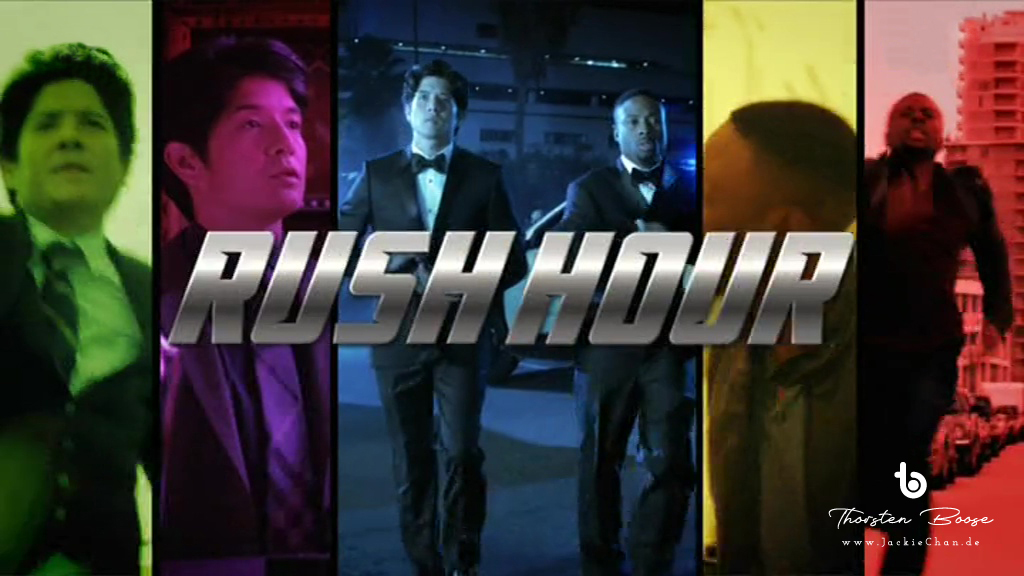
Mega review of the “Rush Hour” television series with Jonathan Foo and Justin Hires
The “Rush Hour” movies are not only known if you are a fan of Jackie Chan. They have made such a big impact in cinema history that you have to have heard of them at least once. But who of you knows that there is also a TV series from the “Rush Hour” universe?
From the creators of the original “Rush Hour” films, namely Brett Ratner, Arthur Sarkissian and Ross LaManna, thirteen episodes were produced in just one season. While the first episodes were still airing in the U.S. on CBS, the series received so many bad reviews that it ended prematurely after just episode eight! In fact, CBS decided without further ado to broadcast the remaining fully produced episodes.
But if you’re expecting Jackie Chan and Chris Tucker to be the main characters of the TV series, you’re wrong. Justin Hires and Jonathan Foo take over the roles of the two detectives Lee and Carter. Jonathan Foo had already filmed several times with Jackie Chan and his stunt team at the time, but that team were not on board here.
I picked up the TV series episode by episode in the fall of 2022, when TELE 5 aired it in its network premiere with a double episode every Thursday starting at 8:15 pm. The series finale featured three episodes in a row. So attached is a detailed review of each episode.
Warning: Spoilers
To say it right up front: I’m going to spoil a lot. Simply because I wanted to write an entertaining review that explores as many aspects as possible. So I’m not just going into the story of each episode, but also following the plot of the entire series.
Background information, Eastereggs and movie references will be described as well. So if you want to watch the series first and then read my opinion, please stop reading now. You have been warned.
List of episodes & reviews
1 | Pilot
Released: 31 March 2016
Director: John Turteltaub
Writers: Bill Lawrence, Blake McCormick, Jim Kouf & Ross LaManna, Idea: Ross LaManna
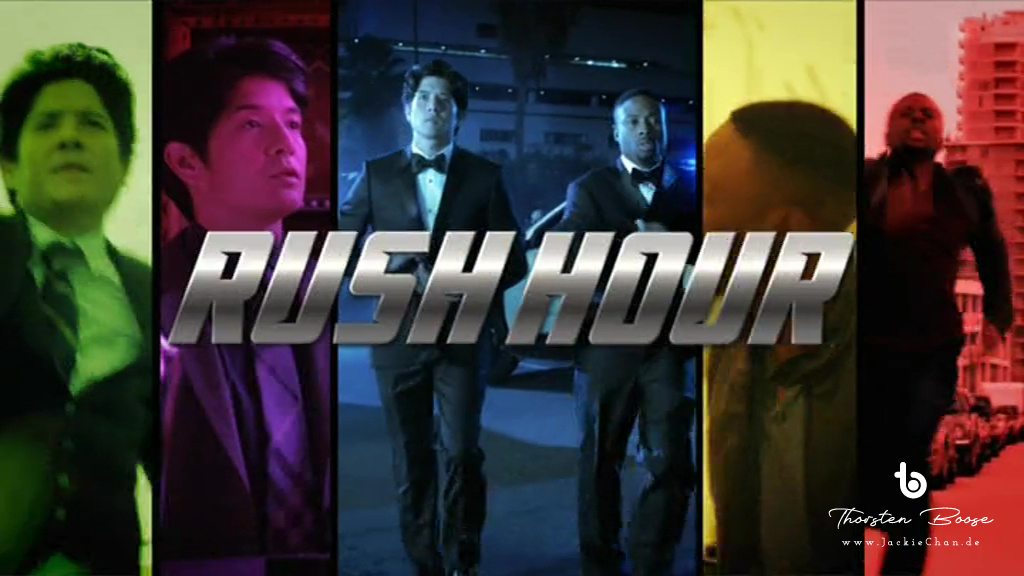
In the pilot episode, detectives Lee from Hong Kong and Carter from Los Angeles come together over a criminal case. Basically, the entire plot of “Rush Hour” (1998) is squeezed into 45 minutes here.
Jonathan Lee (Jon Foo) is a Hong Kong cop who is on a big case with his sister Kim (Jessika Van). Big brother coddles his sister and protects her whenever he can, but Kim wants to prove herself. When she is ambushed by the gang Quantou one day while on command to protect the Terracotta Army, she disappears without a trace. Clues lead to Los Angeles, where eccentric detective James Carter (Justin Hires) is investigating a case that ultimately leads to Lee’s problem.
Both cops team up to bust the Quantou cartel. In the process, they discover the Terracotta Army, but also that Lee’s sister Kim has switched sides and is now working for the bad guys.
Many scenes and settings in the pilot episode are modeled after the first “Rush Hour” from 1998. But the introduction to the story and the characters happens so quickly that the viewer feels caught off guard and can hardly build a relationship. It doesn’t help much if you’re a fan of the original trilogy and already familiar with the ambience.
The series was made by some great minds from the trilogy with Jackie Chan and Chris Tucker, including Brett Ratner, Ross LaManna and Arthur Sarkissian. Even the role of Chris Tucker’s sidekick Johnson, played here as Didi Diaz by Aimee Garcia, makes an appearance. There are minor changes: Carter’s boss is a woman named Captain Lindsay Cole, the LAPD seems more diverse, and the reversed size relationship between Lee and Carter are noticeable and, in my opinion, negatively impact the humor between the two.
What was considered hilarious racist humor in 1998 has been adapted to the zeitgeist in 2016 and simply written out of the script. The scene in which Carter seeks out his cousin Gerald in the pool bar was recreated almost 1:1. But Jackie’s scenes, in this case Jonathan Foo’s, were radically cut. Here, without any exchange of words or misunderstandings between two cultures, there is a direct scuffle, just like that. Yet it is precisely these cultural differences that repeatedly put both “Rush Hour” characters in dangerously funny situations in the original trilogy.
Speaking of scuffles. The action is not absent from the pilot episode, at least the creaters try to get close to the original. Parkour scenes, car chases, fist fights – but it doesn’t want to ignite. This is due to many things, the shaky handheld camera is probably decisive. Its shaky shots make it hard for the viewer to follow a punch or kick. The hectic editing sequence with up to 15 cuts per 10 seconds does the rest. Again, it doesn’t help that Jonathan Foo, as a stuntman and martial artist, can draw on fighting experience in front of the camera. He also worked with Jackie Chan and his stunt team several times in the past, but the choreography of this TV series doesn’t even come close to this high standard.
All in all, especially the fights seem like a 90s TV series, which would actually be thematically fitting, since “Rush Hour” ran during prime time in the 90s. However, the prelude completely loses that charm. Even Jackie and Chris couldn’t have saved it, both have too much screen presence for the small screen.
The pilot is entertaining and may appeal to a small audience, but I’m almost certain that’s not the audience that loves the movies. The makers’ balancing act between a remake with old gags and reboot without movie references fails for the most part – it seems like they weren’t sure which direction they wanted to take.
2 | Two Days or the Number of Hours Within that Timeframe
Released: 7 April 2016
Director: Peter Weller
Writer: Blake McCormick
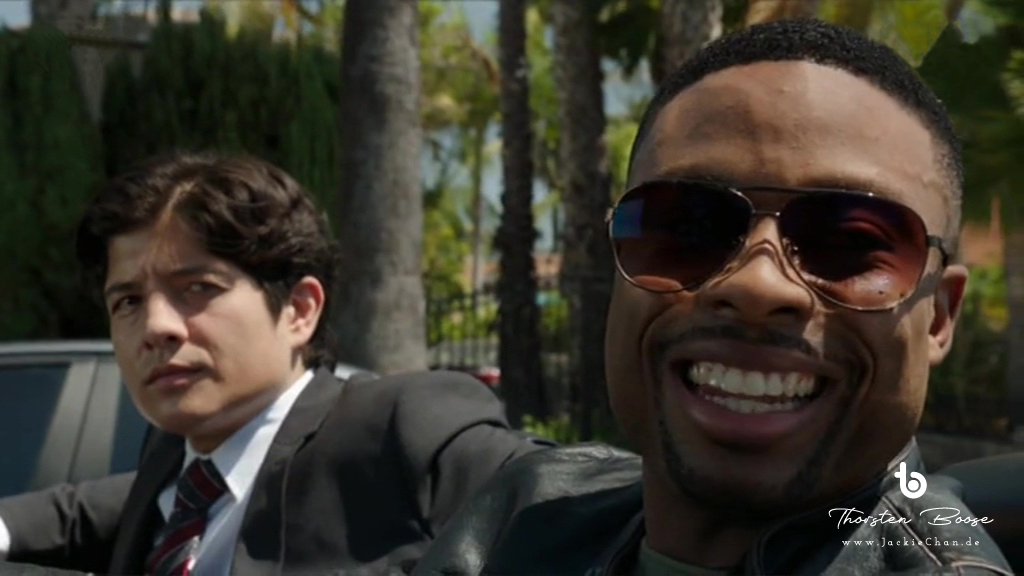
During a burglary in Beverly Hills by masked perpetrators, the victims are robbed and murdered. The LAPD is called to intervene. Meanwhile, Lee has been given a permanent job by Captain Lindsay Cole, who compares the stoic Chinese man to an Asian Orlando Bloom. What about his old boss in Hong Kong? No one knows.
Lee and Carter work together on the case, while in between they continue to try to solve the case involving Quantou and Lee’s sister. After a wild foot chase, Carter’s cousin Gerald is confronted and questioned with a luxury watch stolen from the Beverly Hills home.
Gerald, originally named Luke in “Rush Hour” (1998), is portrayed here without facets as a dimwitted petty ganove, which clashes with Carter’s naive spirit. One wishes for more varied characters already in the second episode, since Lee is also played too seriously, too emotionless. And during the whole investigation Carter still tries to find out the first name of his new partner.
There is a nice homage to Bruce Lee and later Jackie Chan himself. But even these gags somehow don’t work, they come to nothing. The on-screen chemistry of Justin Hires and Jonathan Foo doesn’t seem to be right, the delivery of the punchlines mostly takes place unnoticed in the background of the audience’s attention. For example, when Carter trots along totally exhausted after a superb parkour run by Lee.
What a Chris Tucker would have delivered perfectly with overacting based on the professional artistry of Jackie Chan, simply bumbles along in the TV series without leaving much resonance with the audience. One really notices the difference between television and movie and wonders if “Rush Hour” can be adapted for TV at all.
Even in the second episode, the choreographed fights are unaesthetic and annoying due to too many and fast cuts and handheld camera use. Hardly one action scene takes place in long shot. Jon Foo is not immobile, but certain kicks fail him here, which is really surprising. Unfortunately, a case for the fight choreographer, who was probably also given little time during the strict production constraints of a television project.
The series commits a major mistake. It rarely adheres to the “show, don’t tell!” guideline and seems more like a retelling unwound in time lapse. At least the viewer learns Lee’s full name at the end of episode two.
3 | Captain Cole’s Playlist
Released: 14 April 2016
Director: Sylvain White
Writers: Brian Chamberlayne & Steve Franks
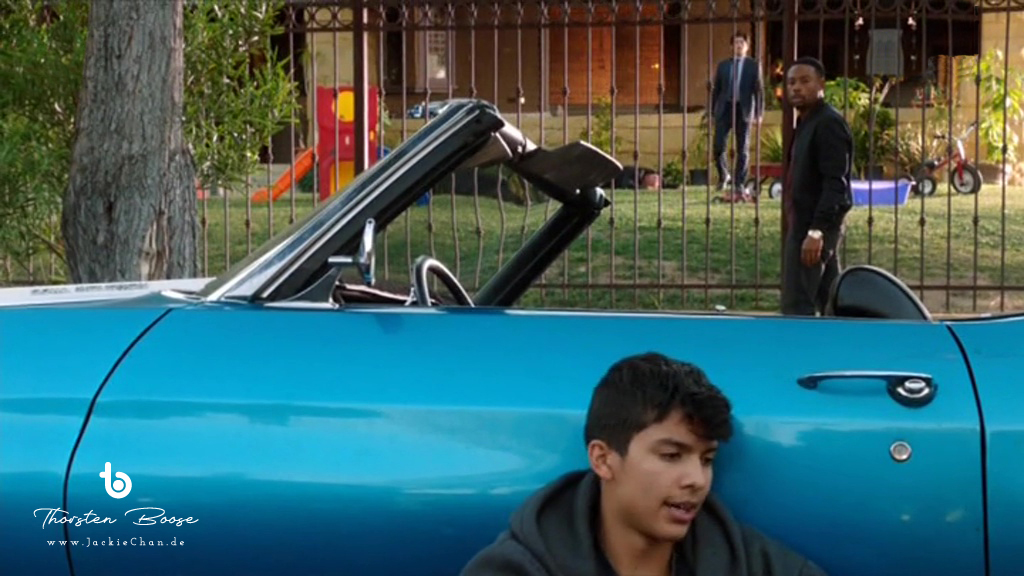
During a nocturnal graffiti action by a masked artist unknown to the viewer, a murder occurs in the neighboring building, which the artist unintentionally witnesses. As he hastily tries to escape the scene, he is pursued by the gangsters – unsuccessfully. Meanwhile, Lee and Carter receive the news that the deputy district attorney can no longer be found. Well, if these actions are connected?
While episode three opens with dark parkour scenes and a few minor bodycam shots, viewers are justified in wondering if the familiar “Rush Hour” charm of the films will finally make an appearance. Spoiler alert: unfortunately, no.
Because even if the creaters reach into the hip-hop sound box, the budget probably wasn’t high enough for the popular tracks. At this point, the award-winning soundtrack of the first and second “Rush Hour” films should be mentioned, both of which boast fantastic tracks and skits.
Somehow the tracks lead quickly and almost not logically for the viewer to a gangster running the drug business in Los Angeles. The writers were not very creative in giving him a name, he is simply referred to as “the Russian”. As if there weren’t enough local gangsters in Hollywood already. Lee and Carter are supposed to track him down, and they enlist the help of a friend.
Gerald, Carter’s cousin, helps the two detectives track down the graffiti artist on the run and beat him down by the Russian. But why is he doing this? Gerald’s motives remain a mystery in the episode, the existence of Gerald’s character has only one reason: to advance the story where the main characters Lee and Carter cannot. And oddly enough, by episode three, Lee is fully integrated into the LAPD and the U.S. – what about his duty station in Hong Kong and his contacts there?
This is where much of the oh-so-charming culture clash between East and West is lost, which is the joke – nowadays some sayings would actually be considered racist – between Lee and Carter. Too bad. Still, as a viewer, one is briefly pleased by the appearance of a 15-year-old Xolo Maridueña, one of the main actors of the hit series “Cobra Kai,” which stems from the “Karate Kid” franchise, to which Jackie Chan and Jaden Smith contributed a kind of reboot in 2010.
Celebrating a female cameo is Mama Fresh Prince, Vernee Watson, who played Will Smith’s mother in “The Fresh Prince of Bel-Air” (1990-1996); Will Smith was a producer on the “Karate Kid” reboot with Jackie Chan and his son Jaden.
That’s about it for this episode, though. A few more small fights with terrible handheld camera movements and way too fast cuts to add spice to the choreography, and the Russian is dead. One less gangster in LA, thanks to the collaboration of a strange team that has no screen presence and doesn’t seem to harmonize. Jon Foo puts on a real physical performance, but not much of it is really memorable given the clumsy storyline that is reeled off and the below average camera work.
4 | LA Real Estate Boom
Released: 21 April 2016
Director: Jimmy Muro
Writer: Cindy Fang
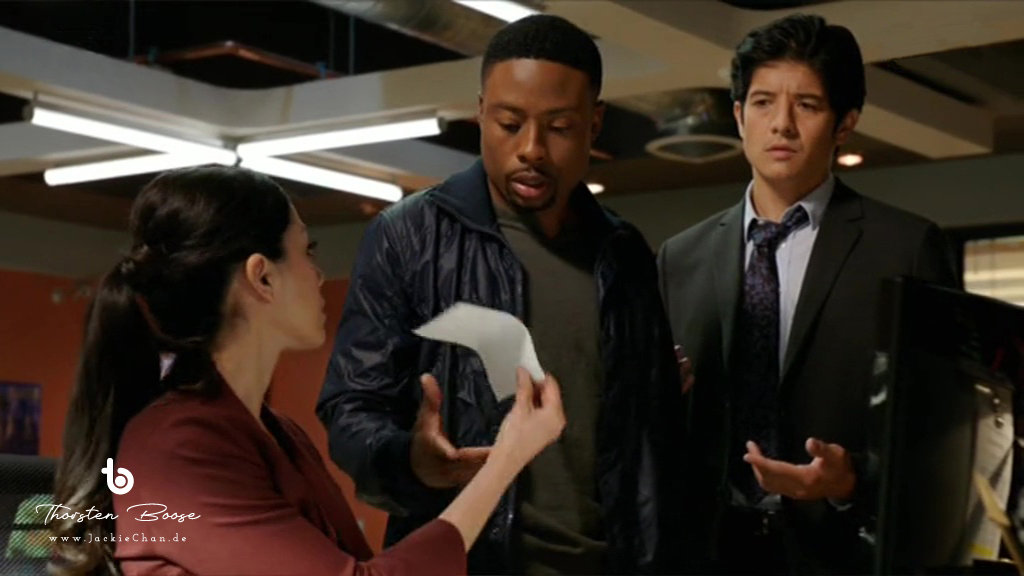
I have mixed feelings about episode four. In fact, I think the story has potential for a great episode and even a full-length feature film if you take it on properly. The story is very convoluted and the viewer only gradually learns what is actually going on. That’s why it’s different from the first three episodes.
Gerald wants to help Lee, who is currently going through a performance slump, find a new place to live. Lee is a minimalist and modest accommodations will suffice for him, but Gerald is a man of the world and knows what Lee really needs to regain his mojo: a home.
While Gerald sets out to find a new place for Lee in the second act, unnoticed by the audience, he and his partner Carter must solve a complicated murder of Councilman Joseph Pena, who blew up in his car. Just like the stoner Dennis Peterson in his trailer and almost the filthy rich boss of Krieg Commercial. But Lee and Carter are able to save him from his chair bomb in old “Indiana Jones” style.
If you look at the “Rush Hour” trilogy on a meta level, you can’t help but notice that creator Brett Ratner was heavily influenced by Indiana Jones. This video shows some parallels of the two successful franchises:
After a lot of back and forth, the culprit is found, but the motive is very questionable and fizzles out in the course of the resolution of the episode. Episode four doesn’t really revolve around another criminal case, but rather wants to deepen Lee’s new roots in the USA, his new home. Unfortunately, both storylines mix so much that neither of them really wants to come to a climax.
A running gag is repeated twice here, namely how Diaz preempts Carter with research. Funny, but not always funny. Unfortunately, the episode’s writers miss having Diaz lead the bomb squad, which would be reminiscent of part one of the trilogy and solidify the feminist nature of Hollywood plots.
Speaking of home, what actually happened to Lee’s sister, the traitor? And why is an extra on the stairs in the banal collision with Lee addressed by Carter as Walters? Is Lee missing a woman in his life? Is this setting up a romance for the next episodes? Let’s wait and see.
For the rest, the episode is quite entertaining, although not really special or even different from the first episodes. However, one notices that the writers promote Cousin Gerald to a serial clown, while Lee’s character has less and less to say and is certainly not funny. On the other hand, Justin Hires manages a small reference to part one of the successful trilogy with a Michael Jackson dance, which is only topped by Jon Foo’s backflip.
5 | Assault on Precinct 7
Released: 28 April 2016
Director: John Putch
Writer: Trey Callaway
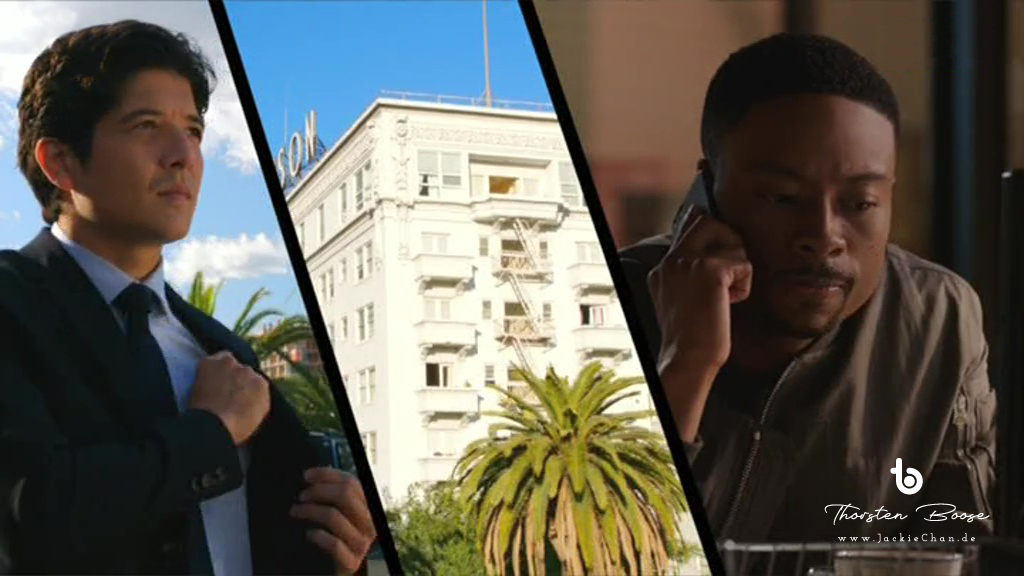
One thing up front: The background music by Lalo Schifrin is missing. What may still work to some extent in the first episodes with a mix of pop and hip-hop, unfortunately finds its nadir in this episode. The soundtrack of the series seems inappropriate, doesn’t underline any emotional developments and only serves as an auditory time sink to introduce the next scene.
With that much criticism, we first launch into the plot, which begins with a flashback to four episodes of “Rush Hour” to remind the viewer that Lee’s lost sister isn’t so lost after all. Is she about to make her series comeback?
A friendly get-together at Didi Diaz’s dinner table introduces the episode and attempts to highlight the culture clash between East and West by having Gerald get a wedgie as punishment for his cheating at the board game. When asked by Lee what that is, Carter replies that it’s pulling up your underpants. A swirlie, that is, sticking someone’s head in the toilet bowl, is probably not known in Hong Kong either, Carter says, while in the next room Gerald actually gets a wedgie.
“Show, don’t tell!” is a guiding principle for screenwriters that is unfortunately ignored far too often in the “Rush Hour” series. The result: As a viewer, you feel like an observer of a narrator who strings together scene after scene and doesn’t really know where to put the punchline.
Kim, Lee’s sister, shows up in the middle of the night at Diaz’s house, where Lee has been staying in a room since he moved. How she knows this remains a mystery, but let’s just assume she’s watching her brother. Lee wakes up from a nightmare, which the viewer witnesses in a flashback: The siblings are watching “Walker, Texas Ranger” (1993-2001) with Chuck Norris as children in Hong Kong when the police there tell them of their parents’ deaths.
Kim seeks out her brother in this episode to tell him about a gang of women smugglers for whom, oddly enough, she herself works. What follows is a fight in the dark that is barely visible, with no sign of emotional sibling rivalry. After a nighttime chase, one wonders why Kim would give her brother info that could incriminate her herself. Nevertheless, the dutiful Lee reports this incident, withholding the information from the LAPD and also from his friend and partner Carter that it is his little sister.
The trust between Lee and Carter becomes clear with the disturbing factor Kim and one expects as a viewer a complex story structure. One is not actually disappointed either, because when Lee tracks down his sister, new characters are introduced to the series: the Dragon (James Hong) runs his gangster business out of an unsightly building complex. The group around Quantou, of which Kim Lee is a member, operates on a large scale in Hong Kong and wants to gain a foothold with human trafficking in Los Angeles and the entire USA.
As the story unfolds, the attentive viewer might notice one or two references to “Rush Hour 2” (2001): Lee hanging unnoticed from the ceiling, the showdown in the spa and smaller shots of Kim Lee in Zhang Ziyi’s outfit. Even if the references were certainly deliberately placed, their effect almost completely fizzles out, as racist slogans like “damn white dumbass” or “Chinamen” are so lovelessly written and delivered that one has to roll one’s eyes in embarrassment.
The fight choreographies are also sub-par and recorded in too dark a setting. Even though Lewis Tan finally brings some screen presence to the series as the villain, his fight against Lee ends as quickly as it began. The subplot involving Gerald, Carter’s cousin who is now back to making money as a small-time crook and providing gags, also feels lost. Gerald gets to show up whenever Carter needs to find someone. As a detective, Carter really has few options when it comes to his informants. And why Gerald is suddenly playing golf in a single scene is also completely absurd.
You can tell that the series was shot under the harsh Hollywood conditions of the units. No one was allowed to fetch their own water, the water boy was responsible for that. The choreographer did the choreo, the cameramen did the shots, but they all didn’t really communicate. Action, cut, next. That’s TV assembly line work. By the way, after five episodes I also criticize the font of the opening credits, because they really could have made it nicer. A homage to the 80s bit-typos would look different.
Before you get bored trying to answer the questions that keep coming up during an episode of “Rush Hour”, only to mentally pack them away into the archives, the creators solve the mystery of Kim Lee. She is, in fact, an agent infiltrated into Quantou to destroy the criminal syndicate from within. Captain Cole knows this now, but has to keep it to himself.
6 | Welcome Back, Carter
Released: 5 May 2016
Director: Steve Boyum
Writers: Brittany Hilgers & Krystal Houghton-Ziv
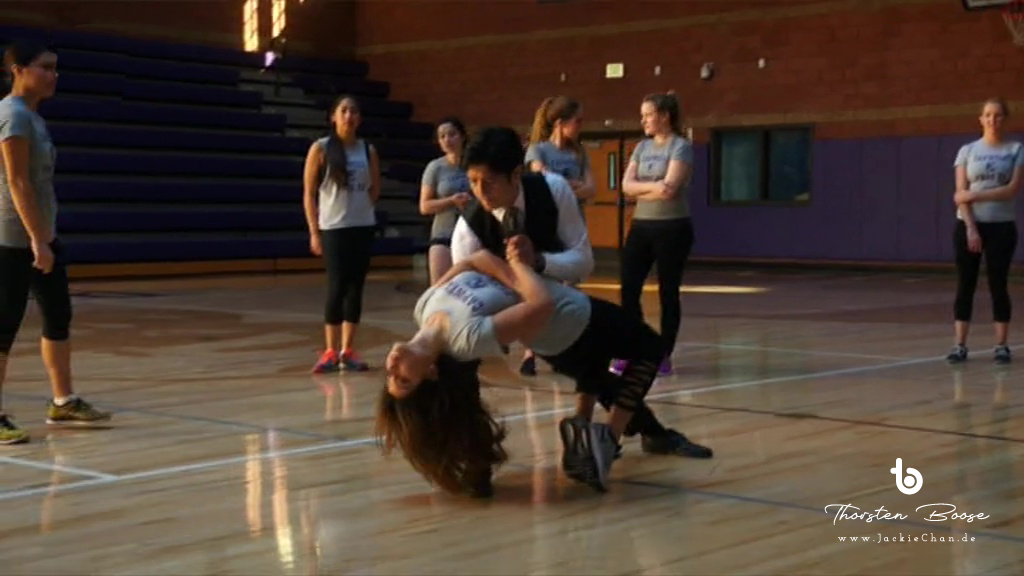
The past episodes have suffered hard from my criticism, even if there was something praiseworthy to report here and there. Already the last episode was qualitatively different from the ones before, and episode six here takes it to the next level.
It begins in a classic crime movie atmosphere. When a student is found brutally murdered in the parking lot after a college team soccer match, the LAPD is called in to protect the students. The dream duo Lee and Carter are assigned to track down the killer and quickly find themselves on the trail of a much bigger case.
Slowly, the emotionally frozen Lee from Hong Kong seems to thaw out in laid-back Los Angeles, but he himself doesn’t know it yet. At the beginning, the viewer is introduced to a new supporting character. The shy, blonde Alice from the forensics department flirts hard with Lee, but he doesn’t seem to show any interest. As the episode progresses, this comes up again decently and one kind of expect Carter to play matchmaker – but that opportunity was probably too cheesy for the writers.
Instead, Lee and Carter are on the trail of a gang of pill poppers. The new drug called Raxxa is making the rounds and killing more and more students at the private Campwell Academy. Captain Cole sends her detectives Lee and Carter to the school as substitute teachers to pick up information directly from the students.
It almost sounds like the plot from “21 Jump Street” (1987-1991), except that Lee sweet-talks the girls in gym class with his dance routines, while Carter takes on the talkative psychologist job. In the past two episodes, viewers realized that Diaz, Carter’s sidekick, is getting more and more involved in the plots, and that’s a good thing. Here, she even has responsibility for remotely monitoring the case and giving orders to her colleague Donovan – Carter’s nemesis, sort of.
It’s a more multi-layered storyline with different characters, with the addition of Gerald as the contact to the street. Now the stakeout can get underway and promptly the viewer is introduced to the bad guys as well. The Sinola cartel, headed by the merciless Elisa Montoya, feels betrayed in its honor and its purse when a competitor sells a cheap Raxxa substitute in their territory. The motives of both sides are clear, but who is the culprit producing the new knock-off?
Diaz, who evolves over the course of the series from Carter’s sidekick and flirt to a strong supporting character with her own backstory, has an idea: “It’s got to be someone who has no idea who they’re messing with.” And with that, the manhunt for a student gets underway, leading them to a shady car mechanic/dealer (played by the great Chris D’Elia), with Didi Diaz getting screentime once again. Honestly, Carter and Lee are playing less and less of a starring role in their own series.
Even though the one fight in Lee’s gym can vaguely be called an homage to Jackie Chan’s “The Accidental Spy” (2001), if anything, this episode stands pretty much for itself as an episode of a crime series with comedy interludes. By the way, these have been on the decline since episode five. As a viewer, one often get the feeling that the creators didn’t agree on whether they should try to revive the wit of the original films or whether they want to produce a prime-time crime series with slightly stale humor to provide occasional corny laughs and smirking corners of the mouth.
In act two, the flirtatious Alice disappears completely, only to reappear in act three flirting with Lee, and you start to wonder if maybe she could be the culprit. But at this point I can reassure you: You don’t have to read that much into the TV series, because it quickly becomes clear to the main characters that it’s one of the students. His motive: He is broke and visits the elite university only thanks to a scholarship.
And while student Henry cooked like a Heisenberg ordered on Wish, I personally recognized some potential in the story. It’s nothing new or innovative, but for the first time while watching “Rush Hour” (2016), I thought, “With some edits, the plot could stand on its own as a movie.” Addendum: “I hope not.” Because I have mixed feelings about “Rush Hour 4,” but that would go too far here.
7 | Badass Cop
Released: 12 May 2016
Director: Steve Boyum
Writer: Steve Franks
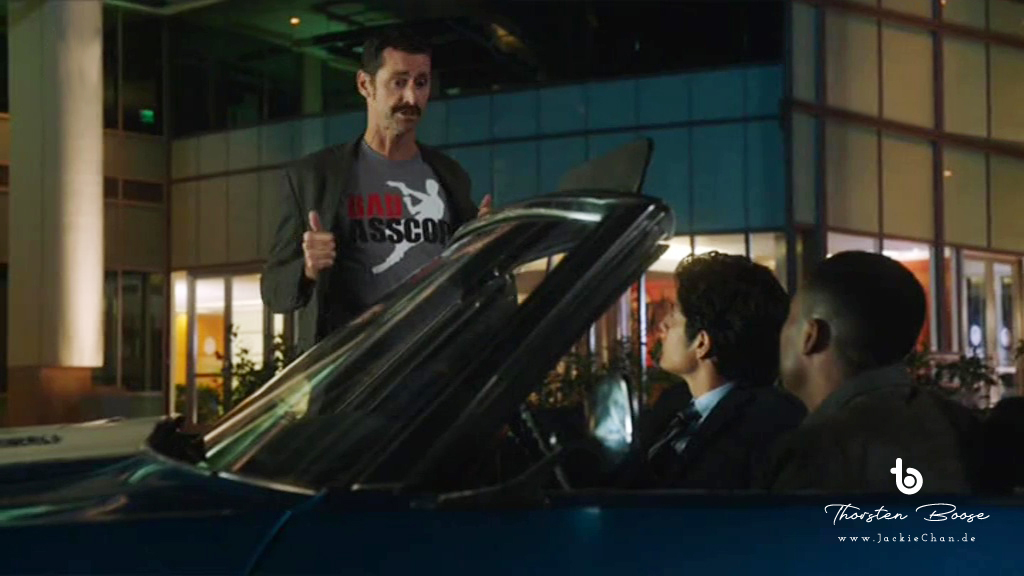
Sometimes it happens that within a series you have to return to an earlier point in the plot to illuminate the hero’s journey from a different angle. Thus, a character can be explored more deeply and new storylines can be added to a more complex series of actions.
One can argue that this was probably one of the motives of the creators behind the seventh episode of “Rush Hour”. The bottom line is that they try to draw the viewer’s attention to two points along the way:
- Lee is on a desperate search for his sister to save the family
- Carter is looking for recognition because he always feels left out
Both are legitimate goals for the characters, but there is one major problem: over the course of the first six episodes, these individual goals were treated too marginally. They were even remedied to some degree for the characters: Lee found his sister several times, who is now obviously working for the U.S., visible for the viewer, for Lee, just not yet. And Carter made quite a respectable name for himself within the LAPD in the past episodes, thanks to his new partner Lee. So where does the sudden desire of both main characters come from?
I think the problem is that the characters in the series were sketched too flatly from the beginning. There was an evolution that took place to some extent, and it had already reached its climax. A kind of reboot had to be done within the current series, firstly to remind us where Lee comes from and that he still has a criminal sister, and secondly to be able to work on new criminal cases.
Unfortunately, this new criminal case is unimaginative: while Carter and Lee are driving a car at rush hour on the Los Angeles highway, they both witness a motorcycle gang robbery of a van. Since nothing was stolen from the van, they tell the press that Lee and Carter beat the gangsters to it – a cell phone video called “Badass Cop” is currently making the rounds on Youtube, from which Carter recognizes himself in a new light.
Who shot this cell phone video is not questioned at all. But the investigation of the two cops leads them directly to the Quantou gang, in which Lee’s sister Kim is active. Lee’s desire to find her doesn’t dissuade him from the idea that this is the work of the Quantou. But further clues lead to an Australian bar owner in Hollywood via a Ukrainian motorcycle gang.
“The Protector” (1985) or “Breaking Bad” (2008-2013) send their regards when Carter and Lee find the bar’s basement, where chemists have set up a drug lab. The fight against old Heisenberg is surprising, but once again the environment is too dark. A thunderstorm of cuts at its best spoils the viewer’s enjoyment of a good beating.
Every now and then while watching, it makes it seem like this is the first episode of the “Rush Hour” series. Some things are brought up that haven’t been an issue for four episodes. Lee has been an established member of the LAPD for months now, but only now are little culture clash gags written in by the writers that seem out of place from this point on. “In China, we start with the victim,” Lee pipes up at one point. A must-see in 2016, in all previous “Rush Hour” films Lee’s origins are deliberately placed on Hong Kong, not China. Times are changing.
What makes this episode even more extremely out of rhythm and seem implausible – if you can assume credibility in a fictional series – is the fact that Carter’s criminal cousin Gerald can randomly steer the plot in a purposeful direction several times. One coincidence per movie/episode is allowed; any more coincidences are just bad writing.
This episode is not good, it has lots of logic flaws. For example, at the beginning Carter lets two motorcyclists get away after being robbed in a completely clear lane, even though he’s been pointing the gun at them for seconds and could have pulled the trigger at a few feet away. Ricochets here would have made it nearly impossible to hit anyone else, but he doesn’t. Instead, in a downtown parking garage, he shoots at a moving car with his partner Carter on top to stop the new suspects and eventual perpetrators.
I won’t reveal the masterminds behind the coup at this point, but a fun gimmick is the fake movie list of the head of the gang, a former stunt coordinator. His son is also in the movie business, and you’ll recognize titles like “Transferrers: Age of Execation” (2014), “The Late Knight Passes” (2012), “The Browne Lethargy” (2012) and even “The Books of Elias” (2010). The series itself also contains such film references: Many episode titles refer to a well-known movie.
The episode started with a flashback to Lee’s sister Kim, got lost in a criminal case in the meantime, and ends with Kim’s hidden appearance, being prepared for a new, very important case by a voice off-screen. It’s a pretty lousy cliffhanger, but I guess it sets up the series for its ending with all the storylines.
Nice little mention: The store where Carter has his “Bad Asscop” shirts printed (no, not a typo) is on Hollywood Boulevard, near where Jackie Chan hung from the famous street sign in “Rush Hour” in 1998.
8 | Wind Beneath My Wingman
Released: 19 May 2016
Director: Maja Vrvilo
Writer: Krystal Houghton Ziv
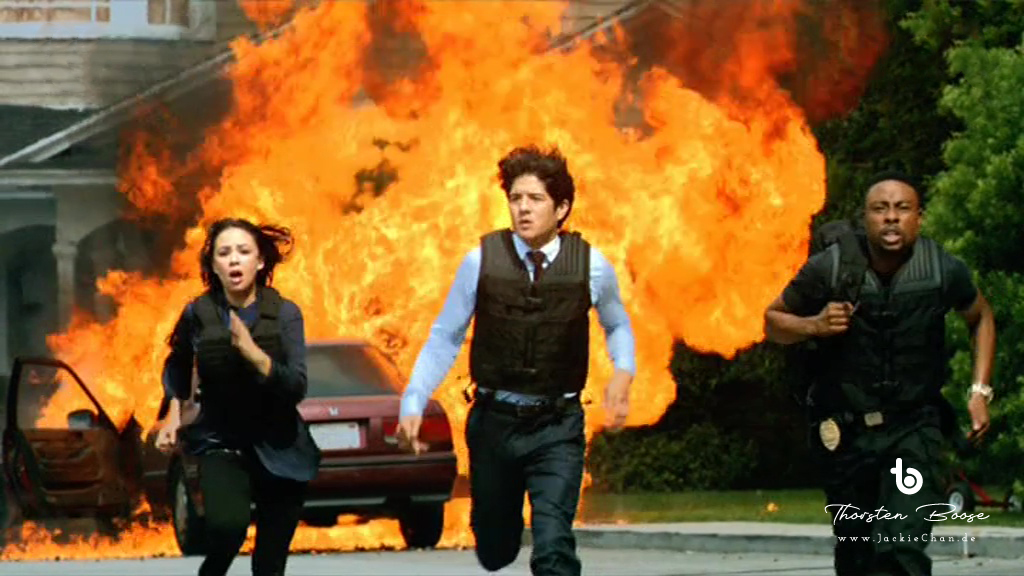
In the new case of LAPD’s mismatched Detectives Lee and Carter, Carter tries to get his amorous money’s worth. When he placed a witness in a safe house six months ago, as he puts it “VL, meaning before Lee”, so that her criminal boss could be investigated, he promptly fell for the young lady. Today, Carter and Lee are to work together to drive the witness to court, where she is to give her testimony against her former boss.
And right at the beginning, things happen that are hard to believe even in a fictional series about the LAPD. The writers have decided to have Donovan, Carter’s nemesis from the precinct – for whatever reason – check both detectives for bugs, which is so bumblingly done that as a citizen of Los Angeles, you wish it wasn’t so in real life. And because Donovan and Carter can’t stand each other, Donovan provides Lee and Carter with an old jalopy to pick up the witness.
When a multimillionaire and his private security firm have been investigated for embezzlement, corruption and criminal assassination after more than six months of hard investigating, no police department in the world allows two cops in a jalopy to drive without an escort to a safe house where the witness lives alone with no additional protection. Of course, the car blows up – couldn’t the makers afford a new one?
Of course, such interludes serve the little sparring that goes on between the main and supporting characters to make the plot more interesting. But too often it seems contrived and trite throughout the “Rush Hour” series. Then, on the run, Carter, Lee and witness Nina Taylor find shelter with a former felon Carter has busted for speeding. What a strange decision, one would have rather expected a hiding place underground with Gerald here.
Unfortunately, that wasn’t possible, because he’s gotten himself a part-time job in the meantime, but is ashamed of it and wants to hide it for fear of his homies. Nevertheless, he drives his cousin Carter, Lee and Nina to the courtroom. But before that, something happens that makes the viewer doubt whether it is cleverly written or just poorly acted by the Nina actress:
The second private safe house at the speedster is quite large with many winding rooms. Yet witness Nina Taylor manages to sit alone on the couch in such a way that she can be seen right across two rooms and the hallway through the door peephole. As a result, she is recognized from the outside by the gangsters apparently hired by her ex-boss Emmett Perry to kill her, and the escape begins anew. Here one rightly wonders: is Nina an accomplice and wants to be found, or was this simply negligent on the part of officers Lee and Carter to place a witness in the line of fire? Wow!
Such coincidences and contrived incidents fall pretty quickly in a discussion in the writer’s room when it comes to how to get fictional characters from point A to point B. Even in episode eight, the production of the entire series seems quite shoddy and quick. And just by that coincidence, another coincidence happens later in the story. Detectives Lee and Carter, as is so often the case, have no control over a case at any time.
Of course, that’s partly what makes a hero so appealing, the vulnerability, however, the entire LAPD in episode eight unfortunately just seems ridiculous. After all, even when Donovan is considered a suspected accomplice of company CEO Emmett Perry, it doesn’t occur to Captain Lindsay Cole to place him under arrest. The whole approach of the characters seems chaotic, out of place, and just listlessly researched when it comes to expert actions like those of police officers.
Throughout the chaos, Carter naturally tries to make a pass at the witness, Nina, only to discover that she was having an affair with her boss. She ended it, however, when she found out he was married. That’s another thing a secretary usually knows, but well, not in the “Rush Hour” cosmos. Carter takes a bit of a backseat in episode eight, which is perfectly okay, because Jon Foo has a few fight scenes again, but unfortunately they ebb away into the sands of nothingness once again. However, his character is allowed to tell an anecdote from his time in Hong Kong for the very first time – this is missing in the entire series.
A great easteregg for movie fans: Gerald eats from a “Let’s Pretzels” box. “Let’s” is a fictional Hollywood brand that refers to the real “Lays” and makes all sorts of snacks, including chips. The “Let’s” brand appears as potato chip bags in many US series, including “Community” (2009-2015), “Brooklyn Nine-Nine” (2013-2021), “Modern Family” (2009-2020) and “New Girl” (2011-2018). Unfortunately, not in the “Rush Hour” films.
The case of USA v. Emmett Perry seems to be more interesting than the whole episode, which is about bringing the witness to the courtroom, but several attempts to murder her try to prevent it. But why would Emmett Perry want to kill her? He doesn’t, someone else does it for him, who wants to take revenge. And why the multimillionaire is actually on trial is not mentioned either; but it doesn’t matter anyway.
Out of fear, Nina moves to London for the time being, and Carter’s months-long amorous efforts end in a friendly kiss on the cheek. Once again, poor Carter receives no recognition for his work. Even if Lee has learned what a wingman is, there were no developments for his character this time.
9 | Prisoner of Love
Released: 23 July 2016
Director: John Badham
Writer: Trey Callaway
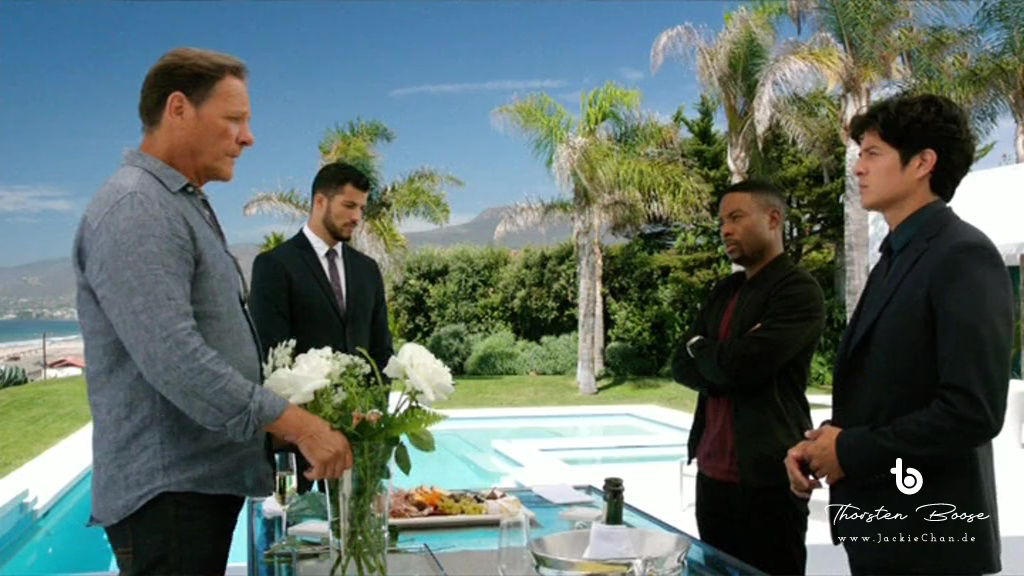
How good that I recorded this episode. Because only in this way I could follow the plot to some extent, by having to follow the first ten minutes a second time attentively. Basically, it’s a simple story that is unfortunately told far too complicated … sorry, shown?!
And that’s again a big problem in episode nine, it’s talked and talked and talked and shown far too little. The guiding principle “show, don’t tell” unfortunately becomes “tell, don’t show” in “Rush Hour” (2016). And perhaps that was one of the reasons why the audience at the premiere was bored after only a few episodes.
About the story: Steven Baker, a convict who has been in prison for twelve years for murder in Boston, breaks out and is on his way to Los Angeles. The FBI needs the help of the LAPD and of course Lee and Carter are put on the case. There is no trace of the FBI throughout the investigation, but the agency is only mentioned in one sentence at the very beginning anyway.
The mismatched duo wonders what a convict from Boston, Massachusetts, is doing in Los Angeles, California. As is often the case, it is Diaz who brings in information with her detective talents. For Carter, who is constantly trying to get recognition, this seems to have become a matter of course by now, and that’s how disrespectfully he treats Diaz. But he doesn’t even notice. So from now on Diaz explains everything to Lee, who on the side as an empathetic cop and sexy co-worker for Captain Cole expands his character traits in the series. Really weird and inappropriate.
It eventually turns out that Steven Baker has an ex-wife in Los Angeles and a daughter, but he has never met her. Now it gets tricky: the daughter knows nothing about her father. And as so often, the viewer can already guess what’s going on at the beginning of the episode. The rest about the villains becomes an annoying accessory.
And these villains come from the deepest depths of the stereotype drawer. Elliot Vaughn was a successful, if shady, lawyer, and Steven Baker’s former boss. In a legal case twelve years ago, not only was Steven Baker jailed, but so was Vaughn’s son. Unfortunately, he was then later murdered in jail. Of course, according to Elliot Vaughn, Steven Baker was to blame.
At this point it gets strange and really ridiculous: The scandal of that time destroyed Vaughn’s law firm, so that he changed his career. In LA he founded a small flower store. His extravagant lifestyle, however, remained with him. And despite this flamboyance, it doesn’t occur to top cops Lee and Carter to take a closer look at him. Seriously? If I’m going broke as a shady lawyer, I’m not starting a little flower store to go underground. That attracts stares. I either start a business consulting firm or work for or with my shady partners.
But we’re long past logic issues with this series. There are far too many of them in this episode as well. For example, after the first act, it is already realized that there was a letter to Steven Baker, probably from his daughter. But it’s only after Baker meets Lee and Carter that the two of them start inspecting it. Then Baker borrows a car, but his passport isn’t checked until he’s been on the road with the car broker for 20 minutes. He then actually jumps out of the moving car. Elsewhere, Carter falls into a pool and his reaction to it is more than strange:
“I hate pools!” What kind of statement is that? Who hates pools? And wouldn’t he have hated it so much if he had fallen into a pond instead? That doesn’t make any sense. But if the writers had written that he hates water, they could have been accused of a racist undertone. Especially since in this particular scene, Carter appears strikingly in the frame with a white-powdered face. No commentary, but grade school level slapstick.
So, since Steven Baker’s daughter had written the letter to her still-unknown dad, she and her mother must now flee because for some reason she overheard that they were in danger. Someone from Elliott Vaughn’s team is after the two of them to use them as bait for Steven Baker so that Vaughn can exact revenge on his son’s death.
And sure enough, the villain, a millionaire and highly criminal gangster, says he’s going to knock him cold among the plants at the Southern California Plant Fair. What the orchid was going on in the Writer’s Room during the review of this episode? The whole thing is supposed to take place unobtrusively among thousands of visitors without silencers, of course.
The initial information chaos of episode nine subsides after a few minutes, but the impression remains that the makers prefer to retell a story here instead of showing it. Still, there is a pearl hidden among all the mussels. Jon Foo pulls off an impressive stunt on the escalator, which is underrated in my opinion. Even if wires were used here, that doesn’t diminish the danger he put himself in. Check him out, is this supposed to be a little reminiscent of “Police Story” (1985)?
10 | Knock, Knock… House Creeping!
Released: 30 July 2016
Director: James Roday
Writer: Carlos Jacott
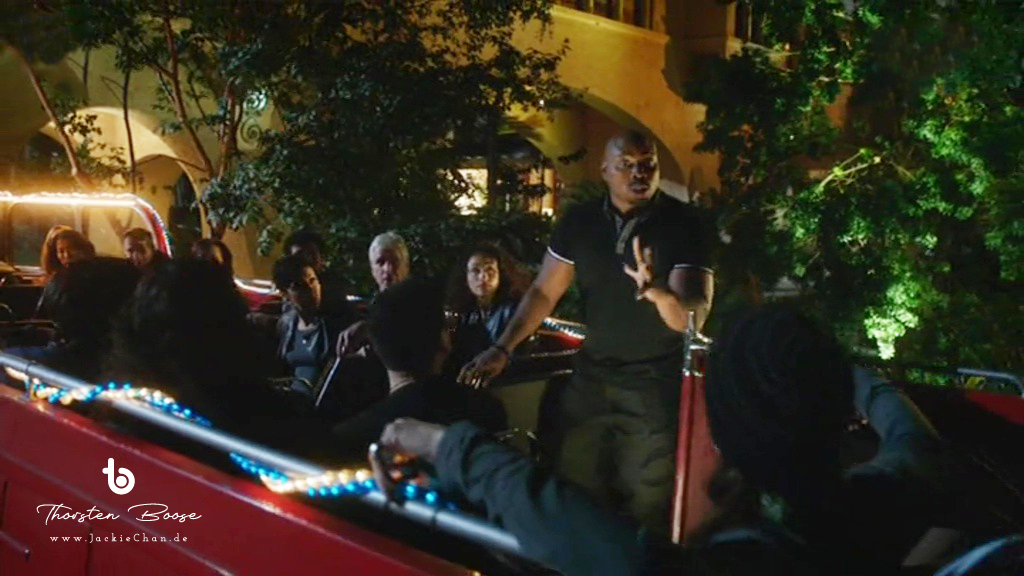
An old case of Captain Cole’s seems to flare up again in LA when a girl disappears during a party at Le Château Franc. Lee and Carter are asked to investigate her sister’s missing person report and quickly find themselves in a maze of information and hotel hallways.
As chaotic as the episode before was, I found episode ten to be orderly and exciting. I would even go so far as to say that it is the best episode of the entire series. The story unfolds, you get background information on the characters in a timely manner, familiar characters have entertaining cameos, and most importantly, the motives of the characters are clear.
Captain Lindsay Cole has been with the LAPD for a long time. When she learns of the missing person case, she gets involved in the investigation. The case has been unsolved for her and she wants to finally close it. She recounts in a great flashback how psychopath Thomas Shea kidnapped, tortured and murdered pretty, young, naive girls at the Château Hotel during her field days. He narrowly escaped her investigation at the time and faked his death.
While Cole’s motive is to clear up an old case, Carter tries to land with the victim’s sister. A daring attempt to combine crime and comedy, which is what the “Rush Hour” films are all about. In this case, it actually succeeds quite well. The writers set up pointed gags, such as when the first suspect is questioned by Carter on his doorstep and Carter replies:
“It’s not that we don’t believe you. We just like your story so much we want to take you down to the station so the others can hear it, too.”
These lines won’t win any Oscars, but it’s one of the most creative snippets of dialogue in the entire series and makes you smirk. The smirk turns into a smile as Lee and Carter finally get to live out their different cultures again, leading to typical misunderstandings that are, of course, amusing to the viewer.
Gerald, Carter’s petty criminal cousin and helping hand on an honorary basis, and Alice, the precinct’s somewhat perky pathologist, also reappear in supporting appearances. Gerald, Lee and Carter ride around Hollywood in a tourist bus at night at the beginning of the episode, which bears similarities to the scene in “Rush Hour” (1998). In this case, I actually find it positive that Jon Foo is not imitating Jackie Chan here, holding on to a Hollywood sign. Instead, the makers direct the focus on the story.
And this is told in a really exciting way for the first time. This is also ensured by tracking shots, new perspectives and zooms that subtly underscore the whole thing. You really notice that these little things, which can leave a big impact on the viewer, were largely missing in the other episodes. Or one was distracted by all the too quickly presented information.
Although the fights here are once again scarce and too darkly harvested, there is praise for a more creative execution. Jon Foo throws in a few subliminal Jackie Chan moves. And in the end, there’s a classic happy ending: the sister is freed, the bad guy is dead, Captain Cole gets to close her old case, Alice gets closer to Lee, and Gerald gets to host the tourist bus. Only Carter, once again, comes up empty.
And unfortunately, Carter is really the weakest link in this story. Instead of stepping out briefly in the torture room with bad cell phone reception, he savagely shuts down Diaz and puts himself, Lee and Captain Cole in danger. I’ve mentioned it before, Lee and Carter often feel alien in their own series – here today, that’s only true of Justin Hire’s character.
And what does a good crime story need? That’s right, a villain. And, boy, what a storybook villain the writers have come up with this time. Not only has he faked his own death as a psychopath and seems to continue living in the murder hotel. No, he’s also working with an accomplice that I won’t mention here.
All in all, after this episode I was satisfied for the first time by “Rush Hour” series standards.
11 | O Hostage! My Hostage!
Released: 6 August 2016
Director: Steve Boyum
Writer: Brian Chamberlayne
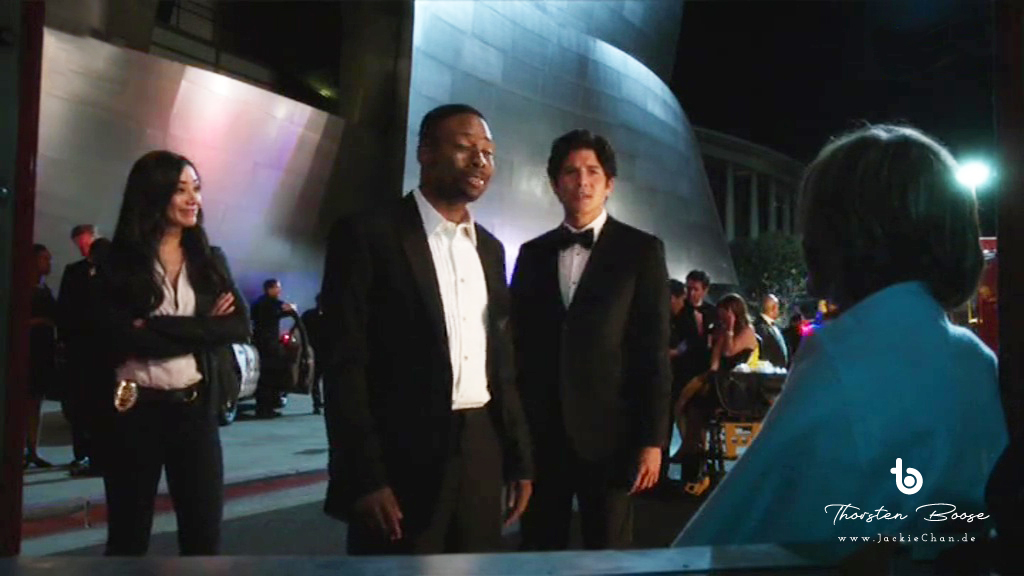
After Captain Lindsay Cole and Detective Carter have had a battle at the LAPD shooting range, which Captain Cole clearly won, she sets off on a date. So for the second time here, we get a glimpse into the day-to-day life of a major supporting character that we would have liked to have seen earlier.
Cole is in the concert hall too early, but as a result witnesses some strange behavior from one of the guests. In typical Captain fashion, she pursues him and has to discover that murders have been committed. The entire concert hall is sealed off and Captain Cole acts as an inside woman without further ado.
The setup seems very interesting and promising at first and reminds us of movies like “City Hunter” (1993) or “Die Hard” (1988). And that’s exactly what Captain Cole gives away at one point, when she tries to encourage a young female hostage:
“Sounds a little like ‘Die Hard.’ I’m Bruce Willis, only with highlights.”
And as a viewer, you still smile at this easteregg and wish that Captain Lindsay Cole would get to really turn it on for once. Through her years of tactical experience, she does, carefully observing the behavior of the hostage takers, who make rather amateurish mistakes. One mistake is the photograph of the girl Cole sneaks up on, enclosed in a hostage-taker’s bag.
Why would hostage-takers carry such powerful evidence to the crime scene? It’s a fair question, and one that Cole must have asked himself. They must be amateurs. Lee and Carter take a back seat in this episode, but that doesn’t detract from the story. They are in contact with their captain, who unfortunately has to deal with bad cell phone network in the concert hall – stupid coincidence!
Carter and Lee try to convince the lead Lieutenant Holt of their evidence that the hostage situation seems to be a diversion, but he and his commander don’t trust the two detectives. In one brief shot, it even looks like Lee doesn’t trust the commander’s truly suspicious behavior. The viewer is deliberately lured onto a false trail to spice up the story a bit.
As it turns out, the daughter of a billionaire, who happens to be in town and goes to a concert alone, is to be held captive for 24 hours in order to transfer a few million to a Swiss account. Demands are made that turn out to be a distraction, and at this point the story could have gotten really exciting “24”-style. But especially in this episode, you recognize Lee’s stoic face and Carter’s annoying behavior as absolutely too shallow. Fortunately, Donovan and Didi Diaz try to bring in some momentum.
Papa Pickering doesn’t want to waste any time and transfers the money. Why not, he has it. Nevertheless, Lee and Carter strangely want to stop him and thus put all hostages in the concert hall in danger. To prevent this, they find their way inside, unnoticed by the hostage-takers and Commander Taymore, where they take out the really badly prepared gangsters.
But who are these people, what is their motive? As it turns out towards the end, a former Pickering employee simply wanted revenge for being kicked out. What a lame story they try to spice up here with various subplots involving Captain Cole, Diaz and Donovan. One is left as a viewer with questions like:
- Why was Captain Cole always tapping her watch?
- Why is there no focus on the Pickerings at the end?
- Why is no one arrested?
- And what was that suspicious behavior of Commander Taymore?
I think, and I may be wrong, that they just wanted to finish episode eleven because they were running out of time. This rushing should also be evident in the last two episodes.
12 | The Dark Night
Released: 13 August 2016
Director: Stephen Herek
Writer: Blake McCormick
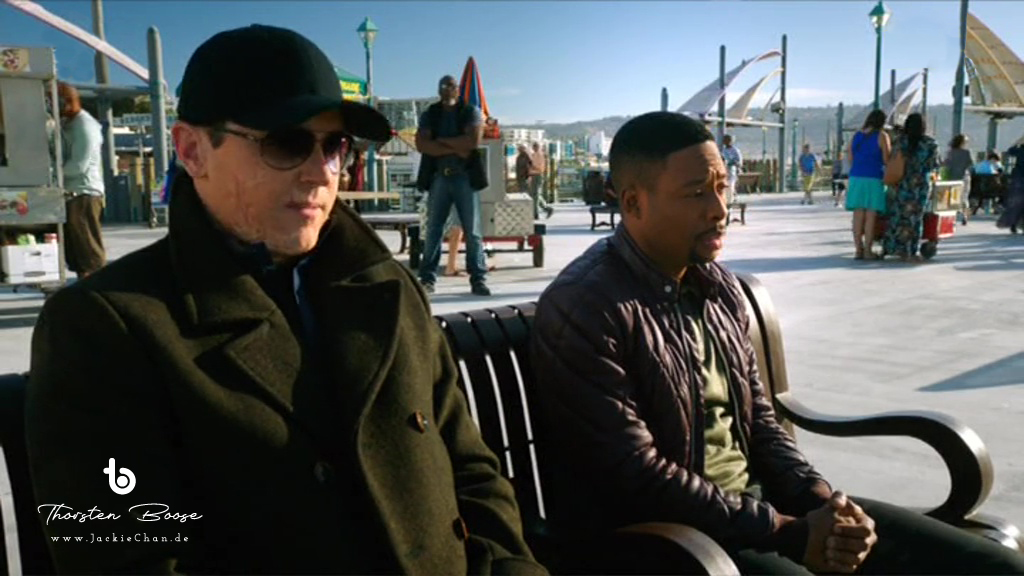
“Swatting” is the word I was privileged to learn thanks to this episode. I guess it means that unknown callers get a kick out of calling in a special task force, even though the actual offense would only require a patrol. In other words, disproportionate use of official resources to play a prank on someone. How that can be implemented in reality remains a mystery to me, and is probably, if anything, a purely American problem.
Detective Lee seems to think so, too, when he and Carter are summoned from Diaz’s house – still Lee’s “temporary” LA safe house – to a briefing by Captain Cole.
A shady TV pastor has been cottoned on and caught at home with hookers. Now his reputation is ruined, something he plans to rectify during his next live sermon. Lee and Carter investigate on the scene and witness the TV pastor being executed with a well-aimed shot to the head live in front of an audience. They catch the killer, but in the parking lot he is also executed while being led away.
For reasons explained far too quickly, the disparate duo subsequently investigate at the famous Redondo Beach, where not a pig is to be seen, except for a technician who talks to himself so loudly that Carter catches him. Again, the writing is apparently lacking in creativity. Carter is knocked out after a car chase and is surprised that the attacker seems to know him – he doesn’t remember him.
The second TV execution takes place live on the open street on the news, when a wealthy white man also has to atone for his sins. With a button in his ear, which was already an important film element in the previous episode, the attacker gives the victim sentences to repeat. Shot, dead, and again right in the forehead. So a trained sniper is working for a psychopath, but why?
Just as you get into the story, you remember that this is the penultimate episode of the entire series, and still no Kim Lee has shown up. Yet she seems to be investigating for the US as an undercover agent. It seems as if the creators wanted to address this in a second season, and it’s at this point that the events start to overtake each other.
Everything happens way too fast, there are plot jumps and, of course, accumulating logic errors. For example, Carter’s criminal cousin Gerald can’t be missed here either. He gets involved in the case, slips information to the team, and even takes part in an undercover operation not authorized by Captain Cole by disguising himself as a technician in order to draw out the scar-faced assassin. His motives, as so often, remain a mystery to everyone. But for Captain Cole and her team they seem logical, because even when she questions the civilian Gerald, it doesn’t occur to her to make it clear that this is against regulations.
Plot holes lead to plot jumps, and all of a sudden Carter remembers an old case after all, when he realizes that the assassin he shot earlier has an artificial leg. Many years ago, Carter rescued a man from a burning car, unfortunately killing his wife and child. This man is now seeking revenge, and attention, on the car manufacturer of his former car!
I could hardly believe my ears when I was presented with this motif. First, I would have thought it more logical that he would turn on Carter for saving him and not his family, so now he has to go through life alone with the pain of loneliness. And secondly, to me, that doesn’t explain the additional motive of why all of a sudden all wealthy people should be to blame for this man’s misery. The explanation that Carter opened his eyes is not enough for me.
Motives, motives, motives … Donovan just gives Lee the key to his motorcycle, even though he’s in competition with him, just to solve the case. As if the LAPD didn’t have cops running around at the scene, or other precincts. Because the car caught on fire then, a couple of managers must be on fire now. And why are the two stooges actually helping Scarface? How can he afford to do that? And why aren’t they being investigated for illegal weapons possession?
In the series “Rush Hour” (2016) you sometimes feel like a player of the old Lego computer game on the island. There is a limited space with limited characters and only a few missions that you can really play. For everything else, there are coincidences, logic errors and Gerald. What an NPC series …
And unfortunately, I have to end the review of this penultimate episode at this point, because just as quickly, the episode itself comes to an abrupt end when Carter has to shoot the scarred face and, in my opinion, waits way too long to do so. The emotional tragedy behind this is not well realized cinematically and actually worth a finale in a feature film, but Justin Hires unfortunately does not have the caliber to channel these emotions in a TV series.
13 | Familiee Ties
Released: 20 August 2016
Director: John Putch
Writer: Trey Callaway & Carlos Jacott
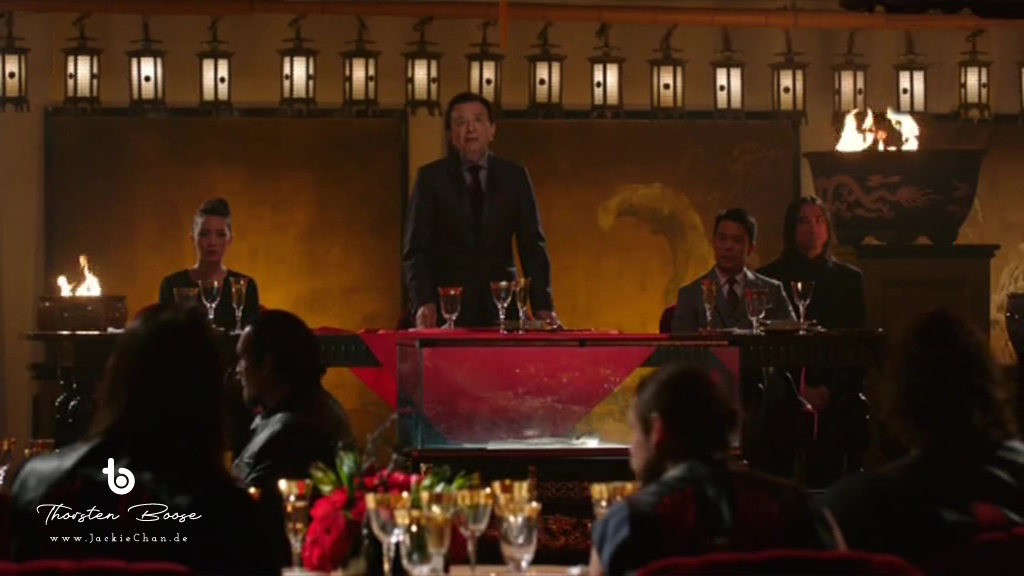
What kept me busy throughout the series was the question: How do the writers bring the broken sibling relationship between Kim and Jonathan Lee back to a point where both can look forward? Because the fact that this conflict had to end in a happy ending was actually clear to me from the start with this type of TV series. Likewise, a reunion in a second season would have a positive effect on the plot development. But as we all know, it didn’t come to that.
After only 13 episodes Jonathan Foo and Justin Hires were finished and I have to say I’m glad. Because more episodes would probably have prevented me from writing this detailed review. Even though Kim Lee comes back in the season finale and some plot holes are plugged, it’s all done more badly than good and is, in my opinion, only meant to serve as a conclusion.
After a short review of Kim’s appearances in the series, the viewer is also reminded that she works undercover for the CIA. Or was it the FBI? In fact, various agencies get mixed up here and one loses track of what’s going on. A recent bank robbery with gas causes turmoil for the LAPD, while at the same time in Hong Kong a beefy villain seems to be stirring up the underground. After episode one, this is only the second time you see the Hong Kong skyline again. Stock material, because it was shot in Los Angeles.
Lee and Carter, the unequal duo, is to find the stolen banknotes. Helping them is the precinct’s technician, Donovan, and sidekick Didi Diaz. As it could not be otherwise, the tracks lead to Gerald. He accidentally got hold of a counterfeit banknote and is now supposed to help solve the case. Why? Well, the LAPD doesn’t seem to have any cops left. This constellation of characters has been static since episode one and is never questioned by the characters themselves.
Kim Lee, meanwhile, is hired by the Quantou boss, the Dragon, played by the great James Hong, to organize a meeting of the biggest syndicates in Los Angeles. Familiar names emerge, such as the Ukrainian mafia, but also new ones. It’s obvious what’s going on: the Hong gang called Quantou wants to take over the American black market, starting in Los Angeles. Did we know this already, but now it’s being reinforced.
James Hong, in a setting far too stereotypical of a Chinese villain, explains how and why he plans to do this. It’s simple: Quantou has been active for several hundred years and therefore it is their right to rule. Let’s just accept that in the finale and hope for a spectacle.
Unfortunately, this does not happen. Until then, there are so many logical errors that I can hardly go into the middle part here. In an early episode, Lee and Carter follow Kim’s sister into a strange area where the dragon has its headquarters. There, Lee attaches a bug to the back of a lamp. So now they want to make the viewer believe that after months, first of all, this bug has not been discovered and secondly, it still works? This element fits perfectly with the story development, because it is the only way for the LAPD to find the meeting of the clans and bust it.
But even that doesn’t happen without problems, because apparently, as mentioned before, the LAPD doesn’t have enough personnel. But wait, wasn’t Kim Lee brought in from the CIA or FBI or MSS to help lead just such a raid? Where are the string pullers from above institutions? Years of hiding Lee’s sister ultimately has zero impact on this story. It merely serves as justification for a well-intentioned plot twist: Because it was the dragon itself that murdered Lee’s parents. Shocking!
And for the first time we experience Jonathan Foo-rios, so that he almost becomes a murderer. But that’s about it for the emotional range. When it turns out in the aftermath that an agent Yu was part of the Quantou and the CIA apparently knew about it, no big fuss is made, but Captain Cole demands that her team be honored. Kim flies back to Hong Kong, tells her brother that he can visit her anytime, but Lee stays in LA for reasons still unknown – there may have been a second season planned at that point – and no change occurs in any of the characters. The final image of the series is indicative of how little development there is in the material, as everyone sits around the table at Diaz’s house. Poor woman, does she actually get rent from Lee? When is Lee going to get his own place? Questions over questions and then it just ended like that.
At this point I would like to thank Christian Sadjak for his support. Thanks to his digital recordings from TV I was able to take screenshots.
For more information about the Rush Hour television series and its associated franchise, check out my German-language podcast episode.
[…] review of the “Rush Hour” television series with Jonathan Foo and Justin Hires” (click here). And I tell you even more interesting facts about the whole “Rush Hour” franchise in […]